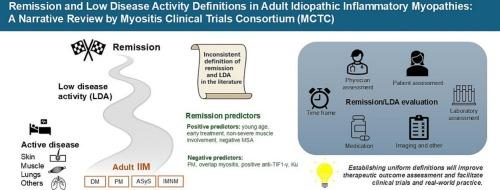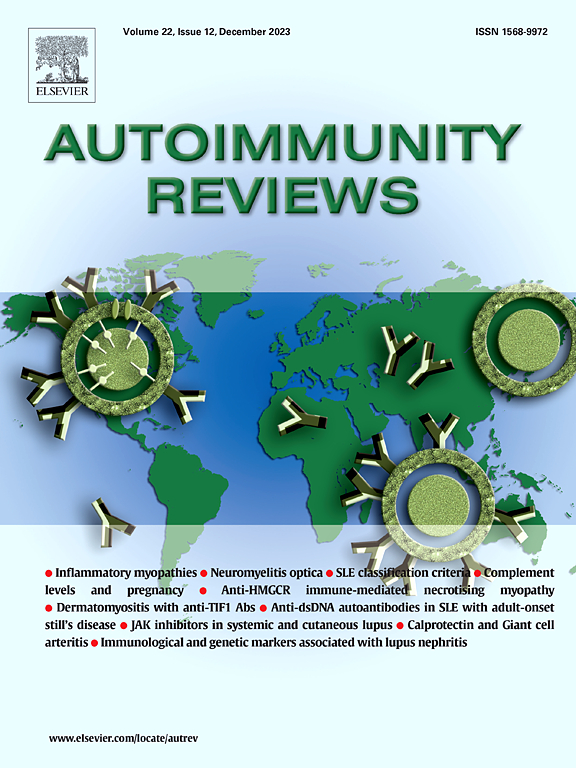Remission and low disease activity definitions in adult idiopathic inflammatory myopathies: A narrative review by myositis clinical trials consortium (MCTC)
IF 8.3
1区 医学
Q1 IMMUNOLOGY
引用次数: 0
Abstract
Idiopathic inflammatory myopathies (IIM) are a heterogeneous group of rare systemic autoimmune rheumatic diseases. Despite advances in treatment, the definition of remission and low disease activity (LDA) in IIM remains inconsistent and lacks consensus and validation. This review summarizes existing published definitions, achievement rates, and predictive factors of remission/LDA in adult IIM, focusing on dermatomyositis (DM), polymyositis (PM), anti-synthetase syndrome (ASyS), and immune-mediated necrotizing myopathies (IMNM). Our literature review revealed a wide variability in remission definitions, incorporating physician assessment, muscle strength, laboratory normalization, and medication tapering or discontinuation. Some studies defined “remission on medication”, while others required complete treatment cessation. Most definitions required a minimum duration of six months. Organ-specific remission (including for the skin, lung, and muscle domains) was inconsistently addressed. LDA has been less extensively studied in IIM, with the myositis disease activity assessment visual analog scales (MYOACT) being the only measure applied to DM. Remission rates varied widely, with stricter criteria yielding lower rates. Factors associated with remission included younger age, early immunosuppressive treatment, non-severe muscle involvement, the absence of myositis-specific autoantibodies (MSA), although some studies reported positivity for certain MSA were associated with remission. Conversely, remission was less likely for patients with PM, overlap myositis, and those positive for anti-TIF1-γ or Ku autoantibodies. Standardized remission criteria incorporating physician assessment, patient assessment, organ-specific parameters, laboratory assessments, and sustained remission duration are essential for harmonizing clinical and research evaluations in IIM. Establishing uniform definitions will improve therapeutic outcome assessments and facilitate meaningful comparisons in clinical trials and real-world practice.

成人特发性炎性肌病的缓解和低疾病活动性定义:肌炎临床试验联盟(MCTC)的叙述性回顾。
特发性炎症性肌病(IIM)是一种罕见的系统性自身免疫性风湿病。尽管治疗取得了进展,但IIM中缓解和低疾病活动性(LDA)的定义仍然不一致,缺乏共识和验证。本综述总结了现有发表的成人IIM的定义、成功率和缓解/LDA的预测因素,重点是皮肌炎(DM)、多发性肌炎(PM)、抗合成酶综合征(ASyS)和免疫介导的坏死性肌病(IMNM)。我们的文献综述揭示了缓解定义的广泛差异,包括医生评估、肌肉力量、实验室正常化和药物减量或停药。一些研究定义为“药物缓解”,而另一些则要求完全停止治疗。大多数定义要求至少持续六个月。器官特异性缓解(包括皮肤、肺和肌肉领域)不一致。LDA在IIM中的研究较少,肌炎疾病活动评估视觉模拟量表(MYOACT)是唯一适用于DM的测量方法。缓解率差异很大,标准越严格,缓解率越低。与缓解相关的因素包括年龄较小,早期免疫抑制治疗,非严重肌肉受累,缺乏肌炎特异性自身抗体(MSA),尽管一些研究报道某些MSA阳性与缓解相关。相反,PM、重叠肌炎和抗tif1 -γ或Ku自身抗体阳性的患者缓解的可能性较小。纳入医生评估、患者评估、器官特异性参数、实验室评估和持续缓解时间的标准化缓解标准对于协调IIM的临床和研究评估至关重要。建立统一的定义将改善治疗结果评估,并促进临床试验和现实世界实践中有意义的比较。
本文章由计算机程序翻译,如有差异,请以英文原文为准。
求助全文
约1分钟内获得全文
求助全文
来源期刊

Autoimmunity reviews
医学-免疫学
CiteScore
24.70
自引率
4.40%
发文量
164
审稿时长
21 days
期刊介绍:
Autoimmunity Reviews is a publication that features up-to-date, structured reviews on various topics in the field of autoimmunity. These reviews are written by renowned experts and include demonstrative illustrations and tables. Each article will have a clear "take-home" message for readers.
The selection of articles is primarily done by the Editors-in-Chief, based on recommendations from the international Editorial Board. The topics covered in the articles span all areas of autoimmunology, aiming to bridge the gap between basic and clinical sciences.
In terms of content, the contributions in basic sciences delve into the pathophysiology and mechanisms of autoimmune disorders, as well as genomics and proteomics. On the other hand, clinical contributions focus on diseases related to autoimmunity, novel therapies, and clinical associations.
Autoimmunity Reviews is internationally recognized, and its articles are indexed and abstracted in prestigious databases such as PubMed/Medline, Science Citation Index Expanded, Biosciences Information Services, and Chemical Abstracts.
 求助内容:
求助内容: 应助结果提醒方式:
应助结果提醒方式:


